
As parliament this week shines a spotlight on the cost of communications in South Africa, it has emerged that Vodacom’s high-end, all-in-one contract packages are significantly more expensive than similar products at other Vodafone-owned operations around the world.
An investigation by TechCentral, in which we compared Vodacom’s Red tariff plans with the Red tariff plans offered by Vodafone in Germany, Spain, Australia and New Zealand, showed that in some cases Vodacom’s rates were more than double.
The exceptions were New Zealand and Germany, which were “only” about 25% cheaper than Vodacom, with a nominal upfront payment or low monthly device fee needed for top-end smartphones.
Vodafone owns 65% of Vodacom.
TechCentral specifically chose the Red plans, which are aimed at higher-spending (and presumably more profitable) customers. We looked for the most comparable options — in most cases, the other countries offer more data and provide unlimited calls (unlike South Africa, where unlimited calls are only available on the most expensive Red VIP plan).
The Red price plans are meant to give users loads of minutes, texts and data, and come with a handset. Vodacom users get a phone of their choice bundled. Most other markets have a (usually small) once-off device fee or minimal monthly handset fee. Most of the cost of the handset is subsidised by the respective operators.
When comparing Vodacom’s Red price plans with those in the other markets, it is glaringly obvious that South Africans are being charged considerably higher prices, and usually for less value.
For example, all price plans from entry-level, mid-tier and high-end plans offer unlimited minutes, with the exception of South Africa. The highest Red VIP package is the only option with unlimited minutes, but that’s at an eye-watering price of R1 999/month. Vodafone New Zealand’s cheapest Red package with unlimited minutes is the equivalent of R645 at current exchange rates (11 February 2014).
Although Vodacom’s Red VIP plan provides subscribers with unlimited calls and texts, it comes with only 2GB of data. In Australia, the same plan costs R992/month — less than half Vodacom’s price — but comes with 5GB of data.

Asked to explain the prices differences, Vodacom says the cost of delivering mobile services varies considerably from country to country.
“Some of the costs such as taxes, license fees and import duties, are set by governments. Others relate to the geographic size of a country, its population density and the availability of fixed-line infrastructure that connects mobile base stations with the rest of the network,” says spokesman Richard Boorman.
“South Africa is larger (in square kilometres) than the Netherlands, Belgium, Italy, France and Germany combined, but our population is less than one quarter the size of those countries,” he adds.
“Over the past six years, we’ve spent more than R30bn building new base stations to reach 99,8% of the population and installing our own fibre-optic transmission capacity,” Boorman says.
“As a country, we don’t have the wealth of fibre infrastructure already in place in other more developed economies. This already puts South Africa at a disadvantage when it comes to the underlying cost of services.
“On top of this, the cost of services in rural areas in particular is very high as we need to fund everything from access roads and diesel for generators, to microwave repeaters for connectivity. Often this rural infrastructure does not provide an economic return and it is, in effect, subsidised by urban areas.” — (c) 2014 NewsCentral Media

